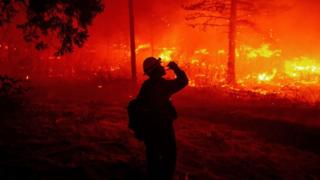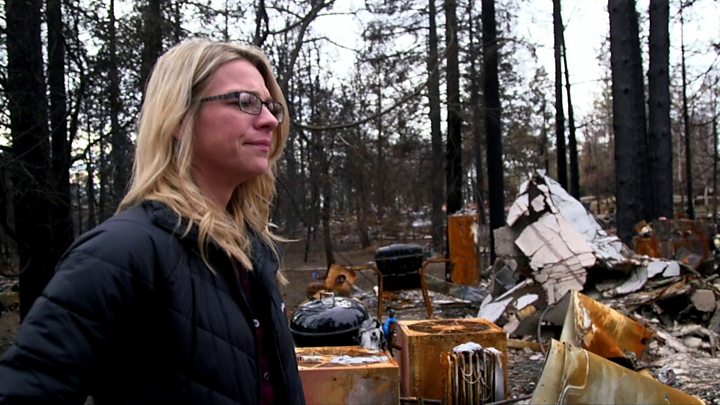Volunteers fighting fires in California’s ‘forgotten canyon’
For several consecutive years, fires have devastated the Californian coast, destroying lives, wildlife and homes. The fire service is under increasing pressure with fewer resources.
One former firefighter has decided to do something about it, and is setting up his own fire crew.
Eric Beninger, who lives in Palo Colorado Canyon in Big Sur, saw many of his neighbours’ homes destroyed by the 2016 Soberanes fire, one of the most expensive wildfires in US history.
The 2017 wildfire season was one of the worst in the state’s history, with more than 9,000 fires burning 1.2 million acres (500,000 hectares). Last year, the Paradise fire alone killed 74 people.
After witnessing the devastation of his own community, Mr Beninger decided to recruit his neighbours and train up an independent fire team to be on standby for future fires.
“When the fire crews finally arrived, they had to decide which houses to just let burn,” he says. “Everything was on fire.”
The Soberanes fire, which burnt for three months, destroyed 57 homes and cost around $260m (£200m) to suppress. Of the 27 homes along Mr Beninger’s road, only eight survived.
The US Forest Service’s response was subsequently criticised for its handling of the fire. Even help from the region’s volunteer service – Big Sur Fire Brigade – wasn’t enough to stop the flames.
“After the fire started, the neighbours mostly fled,” Mr Beninger recalled. “A few of us stayed behind to protect our homes, because we knew we weren’t going to get help. We risked our lives to be here, not knowing what the fire would do.
“Where we live is difficult to reach, it’s secluded. And we were forgotten about.”
Mr Beninger is a carpenter, but used to be a firefighter with the US Forest Service in one of the hotshot crews – teams known as America’s “elite” firefighters due to the danger of their work.
He and two friends helped save three homes from burning – by using water bottles from the Red Cross.
“We had all these little tiny water bottles with Red Cross stickers on. And we were going to houses and putting out fires that threatened the whole home. We’d unscrew the bottle cap a little bit and squeeze them so the water squirted out, rather than just pouring.”
“We had a shovel – no chainsaws though, mine had burnt in the fire. We were just this tiny makeshift fire brigade in a pick-up truck with some water bottles.”
That’s where the idea began, said Mr Beninger, who soon after heard about a small fire truck for sale in nearby Carmel Valley. The owner gave it to him for half the price, and now it’s up to him to restore it and build a team.
The fire truck is built around a 1973 Dodge Power Wagon, and has a four wheel drive, meaning it can access the canyon’s almost-impassable dirt roads.
“At the moment we don’t have a big crew, but we’re speaking with another six neighbours and we’re going to do what we can. We’re going to give everybody basic fire training.”
Mr Beninger is planning barbecues, calendars – “men and women” he noted – and “whatever it takes” to drum up the $10,000 needed to get started.
“The best part is making our community tighter. Having the truck is one thing, but knowing how to use it and bringing everybody closer is more important. I don’t know if we’re going to be able to save any homes, but we’re going to try.”
Mr Beninger predicts the fire is “definitely” going to return.
“There are still materials here to burn, and they’re dry, and there’s more airflow now between everything, so it could be as bad, or even worse, a fire than we’ve had previously.”
CalFire and the US Forest Service are tasked with fighting fires in the region, but thanks to government funding cuts and an increase in demand, resources are stretched.
More on California wildfires
An August 2018 assessment found the state could see a 77% increase in the average area burned by wildfires in 2100.
A Cal Fire report, published in March 2019, noted as many as 15 million acres of California forests are in “poor health”, needing work to boost fire resiliency.
Experts have warned there is now no longer a “typical” California wildfire season, and that the risk may be year-round.
“If the community doesn’t do something to protect itself, who will?” added Mr Beninger.
“I think it’s going to be a great addition to the neighbourhood, it will bring people back together. We were devastated by that fire; families fled, there used to be lots of children here but now there aren’t.
“The fire could’ve been handled within days, but there just weren’t the resources. We’re going to take care of our own.”
The truck’s already got a nickname – Scarlett – which Mr Beninger wants on the uniforms.
“They won’t be anything too fancy, but we might have some scarlet on there, maybe some redwoods , ocean and the mountains. But we’ll have to change the writing on the side of the truck.”
After a few moments he added, with a chuckle: “Maybe we could call it the forgotten canyon fire department?”
Source: Read Full Article




